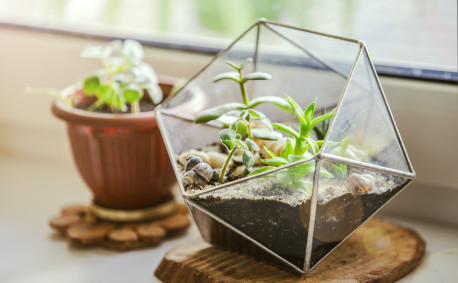The Best Plants to Grow Indoors
During the cold, drizzly months, it’s hard not to long for warmer days. And even after winter is technically over, the Kansas weather can remain dreary and chilled for months to come.
To add a little brightness in your home without relying on Mother Nature, try growing indoor plants. While they aren’t quite as powerful as the sun, houseplants may be able to boost your mood and reduce stress.
If your thumb is less than green, don’t worry! Even the most forgetful gardener will be able to care for these plants.
1. Chinese Evergreen (aglaonema)
First on our list for a reason, the Chinese evergreen is perfect for beginners. Able to grow in any room regardless of sunlight levels, this plant is difficult to kill. You won’t need to worry about watering much, since the Chinese evergreen only requires a sip every few weeks.
Starting small enough to live in a pot on your desk or on the kitchen counter, your plant friend will slowly grow to be a larger decor piece.
2. Spider Plant (chlorophytum comosum)
Named for the many green “legs” jutting in every direction, the spider plant’s leaves hang in a nice arch shape.
Another great choice for newbies, it only needs to be watered once a week. Consider putting this choice in a room with a window or two, as it thrives in natural light.
Bonus: Occasional offshoots can be replanted and make lovely hostess gifts!
3. Jade Plant (crassula ovata)
Looking like a miniature tree, the jade plant grows a trunk with thick, round leaves sprouting from top to bottom.
If overwatered, jade plants can rot, so it’s better to err on the side of (what seems to be) not enough water. To be safe, check the top couple of inches of soil — if they’re dry, go ahead and give the plant a splash. Rooms with plenty of natural light will make this succulent happiest.
4. Chinese Money Plant (pilea peperomioides)
The award for most nicknames goes to this plant! Known as the pancake plant, UFO plant, mirror plant and more, this option is a little harder to find than the others. Many nurseries don’t offer the Chinese money plant because its slow growth means it isn’t as profitable as other species. Your best bet will be to order one online or try repotting a clipping from a friend.
Once you have your hands on it, keep the Chinese money plant in a bright room, but don’t expose it to direct sunlight. Only worry about watering your many-named friend once every couple of weeks — if the plant’s leaves start to droop, you’ll know it needs a drink.
5. Green Heartleaf Philodendron (philodendron hederaceum)
As you probably guessed, this plant has green, heart-shaped leaves that drape nicely once they’re long enough. Hanging vines make it a great candidate to be suspended from the ceiling or a wall.
This plant will tolerate any level of light, but direct sunlight may burn its leaves. For watering needs, use the same soil test as for the jade plant, and only give it more when dry.
6. Aloe
Did you notice aloe doesn’t have a scientific name listed in parentheses? Good catch, smarty pants! This is because aloe itself isn’t a specific plant, but a classification with over 500 varieties under its umbrella.
From the well-known aloe vera to the quirkily named aloe cha cha, care for all aloe types is about the same. Keep your aloe in a bright place, and don’t worry about watering it often. These plants typically won’t require pruning, but if you spot any brown leaves, simply remove them.
7. Rex Begonia (begonia rex)
With touches of purple, red and other colors, rex begonia is a nice way to bring something other than green into your home. Since it won’t grow very tall, consider placing it on a desk or dinner table.
Medium light is the key here, so don’t lock rex begonia in the basement or put it right on the windowsill. Find a nice middle ground. Water this plant about once a week, but try to avoid soaking its leaves, which could lead to rotting.
8. Crown of Thorns (euphorbia milii)
Another colorful friend, crown of thorns boasts a variety of flowers. Be careful, though, “thorns” is in its name for a reason!
For the most blooms possible, place crown of thorns in bright light. While it will survive in medium light, the flowers will only appear if it has enough sun. You only need to water this gem once every few months, since overwatering will cause it to lose its leaves.
9. Mother-in-Law’s Tongue/Snake Plant (sansevieria trifasciata)
Although its name is less than inviting, this plant is actually very pleasing to the eye with large, thin leaves sticking straight up. Adding to the appeal, mother-in-law’s tongue can adapt to almost any indoor condition.
This plant will grow in any lighting, but prefers brighter areas. You’ll be hard pressed to underwater a snake plant — just give it a drink every month or so.
10. Edible Options
If you’re looking to add something aesthetically pleasing and practical, try growing herbs to use in your cooking! A few easy choices are:
- Mint
- Parsley
- Rosemary
- Thyme
- Oregano
- Basil
These options are all small enough to grow in the kitchen without taking too much of your precious counter space.
The perfect pick-me-up to stave off the winter blues as well as being a trendy decoration, your new houseplant will be a welcome addition to your home or office. Happy growing!




